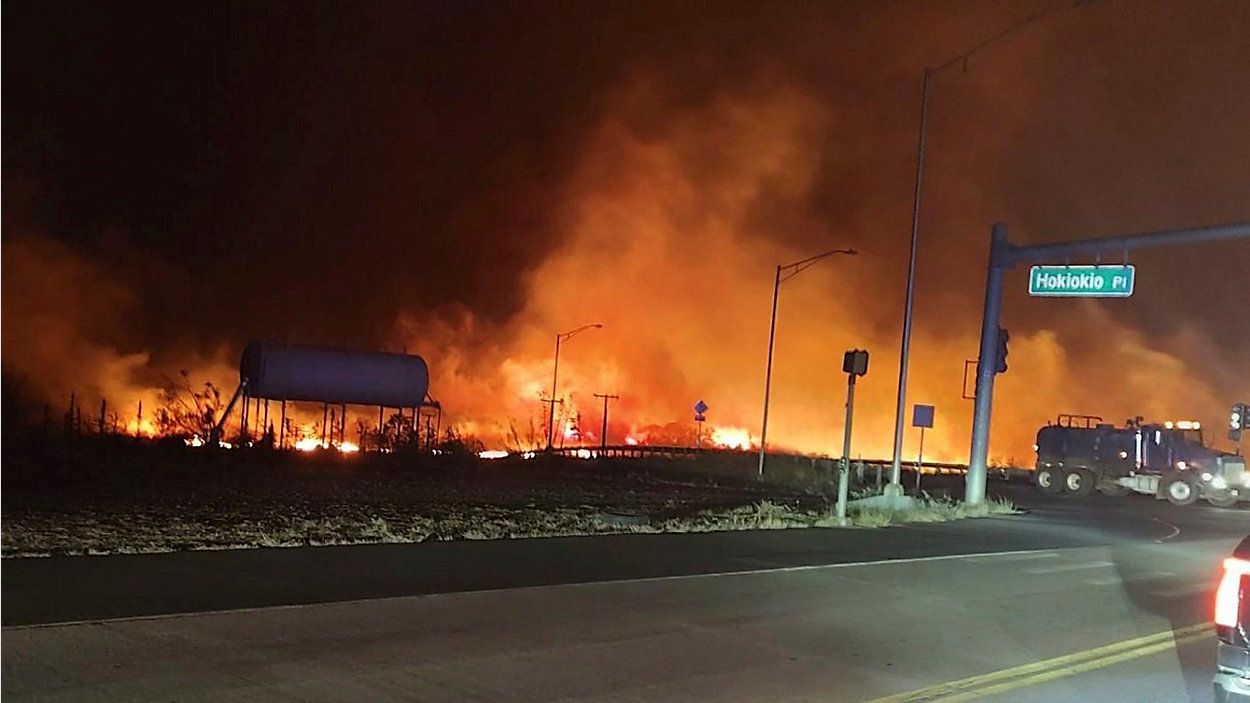LAHAINA, Hawaii — The Aug. 8, 2023, wildfire that razed historic Lahaina and left at least 102 people dead started when broken utility lines along Lahainaluna Road were reenergized, causing sparks to fall on overgrown vegetation below, according to an investigation by the Maui Department of Fire and Public Safety and the U.S. Bureau of Alcohol, Tobacco, Firearms and Explosives.
Results of the investigation were released Wednesday by Maui County and ATF. The fire was officially classified as “accidental.”
According to the report, what was once speculated to have been two separate fires was actually one fire, with a single origin and cause, that involved two separate phases.
According to investigators, the fire started at 6:34 a.m. as a result of the reenergized lines sparking and igniting the unmaintained vegetation near utility pole 25 as well as an overhead power line between pole 24 and 25 falling and igniting the vegetation below.
The fire was brought under control by 9 a.m., with all indications that it was “fully contained and extinguished—no flames, no smoke or perceptibly combusting material were observed for several hours.”
According to the county, embers from the initial phase of the fire remained undetected and were rekindled by a severe wind event around 2:52 p.m., thereby initiating the second, more destructive phase of the fire.
“In sum, the origin and cause of the Lahaina fire is clear: The re-energization of broken power lines caused sparks that ignited unmaintained vegetation in the area,” said Maui fire chief Brad Ventura during the news conference Wednesday at the Kalana O Maui building in Wailuku.
In the weeks following the fire, and before speculation about its origin and cause had been confirmed, Hawaiian Electric publicly stated that it appeared its equipment sparked the fire. On Wednesday, after the MFD-ATF report was released, the utility noted in a news release “our company and our employees have cooperated fully with all government investigators, diligently providing requested information while aggressively advancing our own fire safety measures in parallel.”
“We deeply regret that our operations contributed to the fire that ignited in the morning,” the HECO release stated. “Confronted by an extraordinary weather event and a chaotic situation, our employees brought their best efforts to their jobs, as they do every day.
“We have looked closely at our protocols and actions that day and have made many changes in our operations and resilience strategies to ensure we fulfill our commitment to keep the public safe, especially in extreme weather events, which are becoming more frequent and severe,” HECO stated.
HECO also noted that the MFD-ATF report came to a similar conclusion as a previous report by the state Department of the Attorney General and the Fire Safety Research Institute that the overall devastation in Lahaina resulted from “a combination of many factors and the actions of many parties.”
The MFD-ATF report was the result of a wide-ranging investigation that took more than a year to complete.
Maui fire investigators worked with ATF Honolulu field office, Seattle Field Division and National Response Team on data collection, photo and video analysis and witness interviews in the immediate aftermath of the fire.
ATF consolidated and analyzed the information as the basis for its independent findings and conclusions. According to the county, ATF shared all data and analyses except for electrical data, which was provided exclusively to ATF by Hawaiian Electric in accordance with a nondisclosure and confidentiality agreement.
ATF returned to the fire scene for further investigation in April and May of this year before meeting with MFD in June to review details and findings in its initial draft report. ATF returned again in July and August for additional site visits and interviews. A draft of the report was provided to MFD, followed by a briefing, in September.
“Because MFD was not granted access to this electrical data, it relies on ATF’s findings based on those materials,” the county stated in a release issued on Wednesday.
The MFD-ATF Lahaina Fire Origin and Cause Report can be accessed via the County of Maui and ATF websites.
Looking ahead, HECO said it is continuing efforts to strengthen the resilience of the electric system, including investing more than $110 million to fortify electric infrastructure against extreme weather conditions, improve vegetation management and deploy devices—including 78 AI-enabled detection cameras and 52 weather stations—to help detect and prevent wildfires.
The company also launched its Public Safety Power Shutoff program as a “last line of defense” to prevent utility-related wildfires during extreme weather conditions.
Michael Tsai covers local and state politics for Spectrum News Hawaii. He can be reached at michael.tsai@charter.com.





